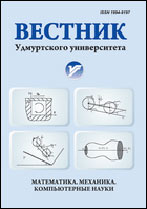|
This article is cited in 2 scientific papers (total in 2 papers)
MATHEMATICS
Bifurcations in a Rayleigh reaction-diffusion system
A. V. Kazarnikovab, S. V. Revinaab
a Southern Federal University, ul. Milchakova, 8a, Rostov-on-Don, 344090, Russia
b Southern Mathematical Institute,
Vladikavkaz Scientific Center of the Russian Academy of Sciences,
ul. Markusa, 22, Vladikavkaz, 362027, Russia
Abstract:
We consider a reaction-diffusion system with a cubic nonlinear term, which is a special case of the Fitzhugh–Nagumo system and an infinite-dimensional version of the classical Rayleigh system. We assume that the spatial variable belongs to an interval, supplemented with Neumann boundary conditions. It is well-known that in that specific case there exists a spatially-homogeneous oscillatory regime, which coincides with the time-periodic solution of the classical Rayleigh system. We show that there exists a countable set of critical values of the control parameter, where each critical value corresponds to the branching of new spatially-inhomogeneous auto-oscillatory or stationary regimes. These regimes are stable with respect to small perturbations from some infinite-dimensional invariant subspaces of the system under study. This, in particular, explains the convergence of numerical solution to zero, periodic or stationary solution, which is observed for some specific initial conditions and control parameter values. We construct the asymptotics for branching solutions by using Lyapunov–Schmidt reduction. We find explicitly the first terms of asymptotic expansions and study the formulas for general terms of asymptotics. It is shown that a soft loss of stability occurs in invariant subspaces. We study numerically the evolution of secondary regimes due to the increase of control parameter values and observe that the secondary periodic solutions are transformed into stationary ones as the control parameter value increases. Next, the amplitude of stationary solutions continues to grow and the solution asymptotically converges to the square wave regime.
Keywords:
reaction-diffusion systems, pattern formation, Lyapunov–Schmidt reduction.
Received: 20.05.2017
Citation:
A. V. Kazarnikov, S. V. Revina, “Bifurcations in a Rayleigh reaction-diffusion system”, Vestn. Udmurtsk. Univ. Mat. Mekh. Komp. Nauki, 27:4 (2017), 499–514
Linking options:
https://www.mathnet.ru/eng/vuu604 https://www.mathnet.ru/eng/vuu/v27/i4/p499
|

| Statistics & downloads: |
| Abstract page: | 320 | | Full-text PDF : | 283 | | References: | 55 |
|




 Contact us:
Contact us: Terms of Use
Terms of Use
 Registration to the website
Registration to the website Logotypes
Logotypes








 Citation in format
Citation in format 
